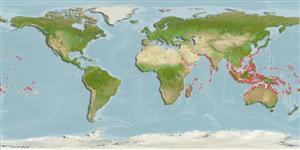Common names from other countries
Environment: milieu / climate zone / depth range / distribution range
Ekologi
Berasosiasi dengan karang. Tropical; 30°N - 34°S, 27°E - 135°W (Ref. 846)
Indo-Pacific: Red Sea and East Africa to French Polynesia, North to Ryukyu, south to Australia.
Length at first maturity / Size / Weight / umur
Maturity: Lm ? range ? - ? cm
Shallow reef environments especially reef margins exposed to strong wave action (Ref. 846), shallow reef tops and edges (Ref. 86439).
Life cycle and mating behavior
Kematangan | Reproduksi, perkembang biakan | Pemijahan | telur-telur | Fecundity | Larva
Members of the class Anthozoa are either gonochoric or hermaphroditic. Mature gametes are shed into the coelenteron and spawned through the mouth. Life cycle: The zygote develops into a planktonic planula larva. Metamorphosis begins with early morphogenesis of tentacles, septa and pharynx before larval settlement on the aboral end.
rujukan utama
Acuan | Koordinator | mitra
Wallace, C.C. 1999. (Ref. 86439)
Status IUCN Red List (Ref. 130435)
status CITES (Ref. 108899)
Not Evaluated
ancaman kepada manusia
Harmless
penggunaan manusia
| FishSource |
Alat, peralatan
informasi lanjut
Umur / SaizPertumbuhanpanjang-beratpanjang-panjangMorfologiLarvaKelimpahan
Sumber internet
Estimates based on models
Preferred temperature
(Ref.
115969): 24.8 - 29.3, mean 28.3 (based on 2322 cells).
kategori harga
Unknown.
